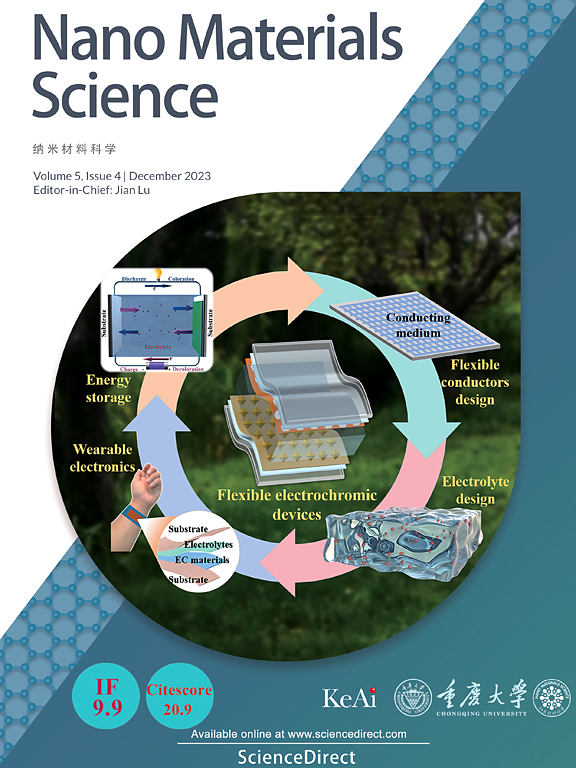p-n结提升双氧化还原光催化:类绣球花Zn3In2S6纳米花偶联六方Co3O4协同制氢和苯甲醛
IF 17.9
2区 材料科学
Q1 Engineering
引用次数: 0
摘要
尽管光催化半还原反应取得了进展,但在同步氧化还原过程中有效利用电子-空穴对仍然存在挑战。本研究涉及构建具有互补带边电位的p-n结Co3O4/Zn3In2S6 (CoZ)杂化。由二维组装纳米结构形成的光催化剂在光照下的最佳产率为13.8 (H2)和13.1(苯甲醛)mmol g−1 h−1 (λ >;420 nm),超过了添加pt的1% ZIS (12.4 (H2)和10.71(苯甲醛)mmol g−1 h−1)。电子空穴利用率达到95%左右。在不添加牺牲剂的情况下,该体系的太阳能制氢(STH)和表观量子产率(AQY)分别为0.466%和4.96% (420 nm),超过了以往的研究成果。这种优异的性能主要归功于相邻p-n异质结的协同发展和有效电荷分离的内置电场。此外,清除剂研究阐明了双重氧化还原过程的复杂机制之谜,在这个过程中,苯甲醛是通过O-H活化和随后的C-H裂解在CoZ杂合体上产生的。此外,优化的1-CoZ复合材料在多种光氧化还原体系中的广泛应用得到了证实。这项工作为实际光氧化还原应用的双功能p-n异质结的构建提供了一个创新的视角。本文章由计算机程序翻译,如有差异,请以英文原文为准。
Elevating dual-redox photocatalysis with p-n junction: Hydrangea-like Zn3In2S6 nanoflowers coupled hexagonal Co3O4 for cooperative hydrogen and benzaldehyde production
Despite advances in photocatalytic half-reduction reactions, challenges remain in effectively utilizing electron-hole pairs in concurrent redox processes. The present study involved the construction of a p-n junction Co3O4/Zn3In2S6 (CoZ) hybrid with a complementary band edge potential. The photocatalyst formed by the 2D assembled-nanostructure portrayed an optimal yield of 13.8 (H2) and 13.1 (benzaldehyde) mmol g−1 h−1 when exposed to light (λ > 420 nm), surpassing 1 % Pt-added ZIS (12.4 (H2) and 10.71 (benzaldehyde) mmol g−1 h−1). Around 95 % of the electron-hole utilization rate was achieved. The solar-to-hydrogen (STH) and apparent quantum yield (AQY) values of 0.466 % and 4.96 % (420 nm) achieved by this system in the absence of sacrificial agents exceeded those of previous works. The exceptional performance was mostly ascribed to the synergistic development of adjoining p-n heterojunctions and the built-in electric field for effective charge separation. Moreover, scavenger studies elucidated the intricate mechanistic enigma of the dual-redox process, in which benzaldehyde was produced via O-H activation and subsequent C-H cleavage of benzyl alcohol over CoZ hybrids. Furthermore, the widespread use of the optimal 1-CoZ composites was confirmed in multiple photoredox systems. This work presents an innovative perspective on the construction of dual-functioning p-n heterojunctions for practical photoredox applications.
求助全文
通过发布文献求助,成功后即可免费获取论文全文。
去求助
来源期刊

Nano Materials Science
Engineering-Mechanics of Materials
CiteScore
20.90
自引率
3.00%
发文量
294
审稿时长
9 weeks
期刊介绍:
Nano Materials Science (NMS) is an international and interdisciplinary, open access, scholarly journal. NMS publishes peer-reviewed original articles and reviews on nanoscale material science and nanometer devices, with topics encompassing preparation and processing; high-throughput characterization; material performance evaluation and application of material characteristics such as the microstructure and properties of one-dimensional, two-dimensional, and three-dimensional nanostructured and nanofunctional materials; design, preparation, and processing techniques; and performance evaluation technology and nanometer device applications.
 求助内容:
求助内容: 应助结果提醒方式:
应助结果提醒方式:


